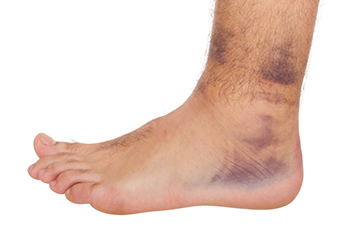
Ankle sprains vary in severity and are classified into three grades. A Grade 1 sprain is mild, involving slight stretching of the ligaments with minimal damage. It typically results from a minor twist or roll of the ankle, often seen in everyday activities. A Grade 2 sprain is more severe, with partial tearing of the ligaments. This type usually occurs from a more significant impact or an awkward landing, leading to moderate pain and swelling. The most serious, a Grade 3 sprain, involves a complete tear of the ligament. This severe injury often results from high-impact events or sudden, forceful movements, causing intense pain, swelling, and instability. Each grade requires specific treatment and rehabilitation to ensure proper recovery and prevent future issues. If you have suffered an ankle sprain, it is suggested that you visit a podiatrist who can determine what the grade is, and offer appropriate treatment options.
Although ankle sprains are common, they aren’t always minor injuries. If you need your ankle injury looked at, contact Edward Fryman, DPM, FACFAOM from Seaford Foot Care Center. Our doctor can provide the care you need to keep you pain-free and on your feet.
How Does an Ankle Sprain Occur?
Ankle sprains are the result of a tear in the ligaments within the ankle. These injuries may happen when you make a rapid shifting movement while your foot is planted. A less common way to sprain your ankle is when your ankle rolls inward while your foot turns outward.
What Are the Symptoms?
- Pain at the sight of the tear
- Bruising/Swelling
- Ankle area is tender to touch
- In severe cases, may hear/feel something tear
- Skin discoloration
Preventing a Sprain
- Wearing appropriate shoes for the occasion
- Stretching before exercises and sports
- Knowing your limits
Treatment of a Sprain
In many cases, the RICE method (Rest, Ice, Compression, and Elevate) is used to treat ankle sprains. However, you should see a podiatrist to see which treatment option would work best with your injury. In severe cases, surgery may be required.
It is important to ask your doctor about rehab options after you receive treatment for your injury. Stretching, strength training, and balance exercises may help the ankle heal while also preventing further injury.
If you have any questions, please feel free to contact our office located in Seaford, and Bethpage, NY . We offer the newest diagnostic and treatment technologies for all your foot care needs.
